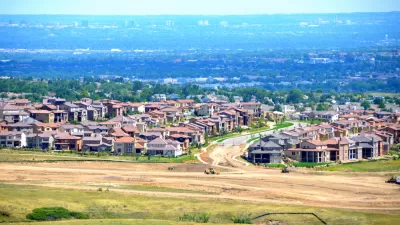Residents of the city of Lakewood have approved a ballot measure that caps annual residential development and requires City Council approval of all developments over 40 units.

"Voters in Colorado’s fifth-largest city on Tuesday approved a cap on residential construction that will be among the strictest in the metro area," reports John Aguilar.
Voters approved Question 200 with 53 percent of the vote, thus capping "the construction of new homes and apartments each year to no more than 1 percent of the existing housing stock in the city and would require City Council approval of large development proposals," according to Aguilar. According to Question 200, the "City Council must give explicit approval to any project that has at least 40 units."
Question 200 had a long route to the ballot box, clearing multiple legal hurdles before appearing before voters. The public approved the law despite most of the money spent on the campaign was devoted to defeating the measure.
Lakewood Mayor Adam Paul opposed Question 200, but most of the soundbites in the article are sourced from residents celebrating a victory.
Also voicing support for the vote, an opinion piece written a few days after voters approved Question 200 makes the case that the slow growth measures implemented by Question 200 will equal an effective climate action plan. Gary Wockner, the author of the opinion piece, hinges the argument on this paragraph:
Simple back-of-the-envelope math tells you that if you have less human consumers, you will have less population-caused GHG emissions. By slowing population growth, Lakewood will slow its GHG emissions — every city in Colorado could do the same thing, as could the state.
Wockner's argument in support of slow growth as a climate change mitigation measures has been directly refuted in the past.
FULL STORY: Lakewood voters pump brakes on home building, pass slow-growth initiative in special election

Planetizen Federal Action Tracker
A weekly monitor of how Trump’s orders and actions are impacting planners and planning in America.

San Francisco's School District Spent $105M To Build Affordable Housing for Teachers — And That's Just the Beginning
SFUSD joins a growing list of school districts using their land holdings to address housing affordability challenges faced by their own employees.

The Tiny, Adorable $7,000 Car Turning Japan Onto EVs
The single seat Mibot charges from a regular plug as quickly as an iPad, and is about half the price of an average EV.

Seattle's Plan for Adopting Driverless Cars
Equity, safety, accessibility and affordability are front of mind as the city prepares for robotaxis and other autonomous vehicles.

As Trump Phases Out FEMA, Is It Time to Flee the Floodplains?
With less federal funding available for disaster relief efforts, the need to relocate at-risk communities is more urgent than ever.

With Protected Lanes, 460% More People Commute by Bike
For those needing more ammo, more data proving what we already knew is here.
Urban Design for Planners 1: Software Tools
This six-course series explores essential urban design concepts using open source software and equips planners with the tools they need to participate fully in the urban design process.
Planning for Universal Design
Learn the tools for implementing Universal Design in planning regulations.
Smith Gee Studio
City of Charlotte
City of Camden Redevelopment Agency
City of Astoria
Transportation Research & Education Center (TREC) at Portland State University
US High Speed Rail Association
City of Camden Redevelopment Agency
Municipality of Princeton (NJ)





























